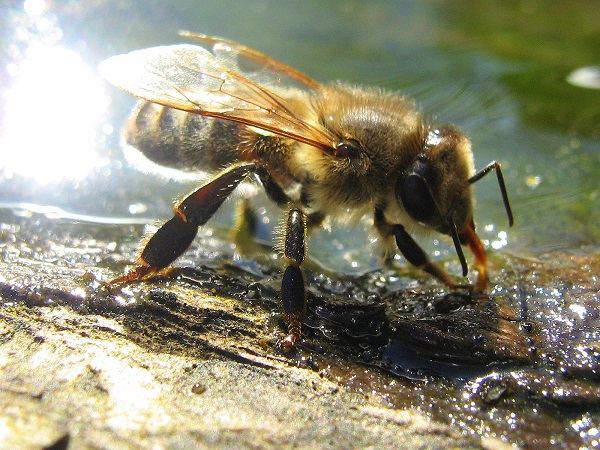

Like all animals, honey bees need a dependable source of water year round. The best water sources for bees are ones that won’t go dry in the hot season, won’t drown the bees, and won’t be shared with livestock. Although honey bees adore a nice salt water pool, it’s a good idea to establish your water source before your bees begin chasing away the sunbathers.
Honey bees drink water like other animals, but they also use it for other purposes. In the cold especially, honey bees use water to dissolve crystallized honey and thin honey that has become too thick and viscous. Due to heat, they spread droplets of water along the edges of brood comb, and then fan the comb with their wings. The rapid fanning sets up air currents that evaporate the water and cools the nest to the right temperature for raising baby bees.
Honey Bees Collect Four Things
In a healthy honey bee colony, foragers collect four different things from the environment. Depending on what the colony needs at a particular time, the bees may collect nectar, pollen, propolis, or water. Both pollen and propolis are carried in pollen baskets on the bees’ hind legs, whereas water and nectar are carried internally in the crop.
In most cases, a bee will collect the same thing all day, one trip after another. So once a water-carrying bee transfers her load of water to a house bee, she goes back to the same source and fills her crop again. However, sometimes a forager can’t find a house bee willing to accept her load of water. If that happens, she knows the colony now has all the water it needs, so she begins to forage for something else instead.
Honey bees often choose water that is “inappropriate” to the rest of us. They may choose stagnant ditch water, slimy flower pots, muddy mole holes, or a pile of wet leaves. Unfortunately for rural and beekeepers, they are also attracted to the smell of salt and chlorine, which are frequently added to swimming pools. While it seems logical to supply sparkling clean water for your bees, they will probably ignore it.
The Best Water Sources for Bees Have a Smell
When deciding on the best water sources for bees, it helps to think like a bee. Although every bee has five eyes, bee eyes are attuned to detecting motion and changes in light levels, not the detail we are accustomed to seeing. In addition, bees travel high and fast, so they may easily overlook potential water sources.
Biologists believe that bees probably find most of their water by scent rather than sight, so a water source with a smell will be more attractive. Water that smells like wet earth, moss, aquatic plants, worms, decomposition, or even chlorine, has a better chance of attracting a bee than sparkling water straight from the tap.
Smelly or slimy water sources have the advantage of containing a wide range of nutrients as well. Although a bee gets most of her nutrients from nectar and pollen, some water sources are rich in vitamins and micronutrients that can boost honey bee nutrition.
 Contact Jaguza Support
Contact Jaguza Support